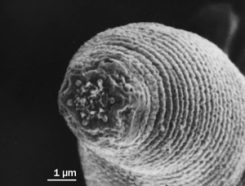Deep-down worm is far out
New worm discovered almost a mile underground could hint at life on other planets

Some worms live in the soil, and they’re easy to spot after a spring rain (or in the garden). Others live in the sea and make their homes in coral reefs. Worms can live in trees and even inside the human body. But recent discoveries in a South African gold mine show that some worms live in even more remote places: The cracks of rocks buried deep underground.
It’s an exciting discovery, and not just for worm scientists. If worms can survive in extreme underground environments, then perhaps similar life exists deep beneath the surface of other planets. Scientists already knew that single-cell organisms live in harsh, dark environments miles underground. But worms, which have lots of cells, are a different story. The study suggests that underground life may be a lot more complicated than scientists previously thought.
“To actually go out and start looking for multicellular organisms is such a game changer,” Tullis Onstott told Science News. “Nobody in their right mind would think they were down there.” Onstott, a geomicrobiologist at Princeton University in New Jersey, was part of the international team of scientists that made the discovery. A geomicrobiologist studies how tiny organisms inhabit and change the material in Earth’s crust.
In their right minds or not, these scientists went digging. They collected samples from six deep holes at the gold mine. And while they didn’t find gold — or if they did, it wasn’t in their scientific report — they did find a female nematode living in rock nearly three-quarters of a mile underground. Nematodes are tiny worms known for being adaptable. The nematode the team found in the mine was a new species, and the scientists named it Halicephalobus mephisto.
That wasn’t the only discovery. A little more than half a mile down, the researchers found two kinds of nematodes already known to live on the surface. And more than two miles underground, the team discovered traces of nematode DNA in the water coming from cracks in the rocks. DNA, or deoxyribonucleic acid, is inside every living organism on Earth. It is a molecule that looks like a long, twisted staircase and it contains all of the genetic information of an organism. Genetic information contains the instructions for how to build and keep running all the parts of an organism.
At the laboratory, the scientists conducted tests to make sure the worms were the real deal — and not carried in by mine workers. The team found that the nematodes lived in water thousands of years old, which means the worms were probably there long before mines or mine workers showed up.
Gaetan Borgonie, a worm expert at the University of Ghent in Belgium, led the study. He told Science News he suspects that the worms’ ancestors lived on Earth’s surface and over time, dug deep.
Not everyone is convinced, including R. John Parkes, who studies underground life at Cardiff University in Wales. Parkes told Science News that he wonders if drilling the holes for the mine somehow changed the underground environment, making it possible for worms to live in such an unusual place.
POWER WORDS (adapted from the New Oxford American Dictionary)
nematode A large group of related worms with slender, unsegmented, cylindrical bodies. Nematodes include roundworms and threadworms. They are found in soil and water, and many are parasites.
DNA A material present in all living organisms and the carrier of genetic information. A DNA molecule is shaped like a long and twisting ladder.
bacteria Tiny, single-cell organisms that can live almost anywhere on Earth. Some can cause disease.
multicellular Having or consisting of many cells.







